Star of the show: HMS Duke of Wellington (1852)
The Royal Navy Flagship in 1853
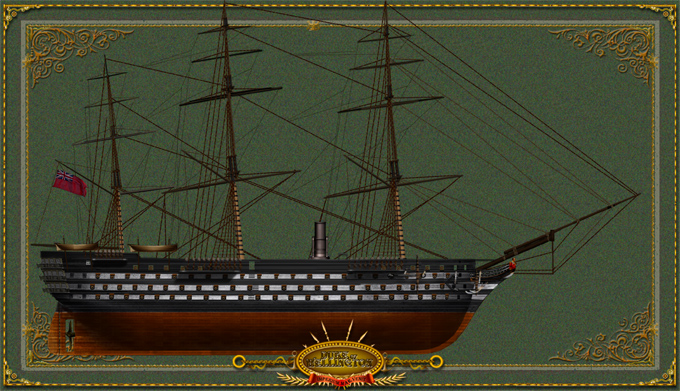
When reports on the French building the Napoleon, the first steam-powered, screw propelled steamship of the line came out to British naval intelligence, it caused some turmoil in the admiralty and the House of Commons as well. In 1948, when the ship was launched, the Royal Navy has already ordered many conversions of sailing ships while on the stocks, and in 1851, it was the case for the Windsor Castle, already in construction at Pembroke Dockyard. It was back in 1849, the first of a new class of giant “wooden walls”, heavy four-deckers, the finest designed yet sailing ships of the line, representing the pinnacle of their breed.
The Windsor Castle was initially designed by Sir William Symonds, but plans and construction were supervised later by his assistant surveyor, John Eyde, and aided in 1852 by capt. Baldwin Walker. But in December 1951, the Admiralty launched a race for a steam-driven battle fleet, the sooner, the better.
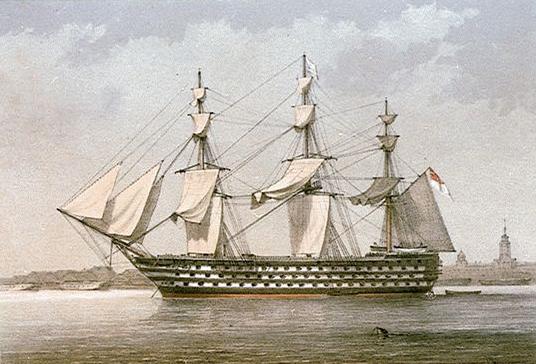
To shorten all delays, many ships in various building or achievement stages, were converted on the stocks, receiving a steam engine, and a screw, already tested with success in various ships, the first being the British SS Archimedes in 1839…
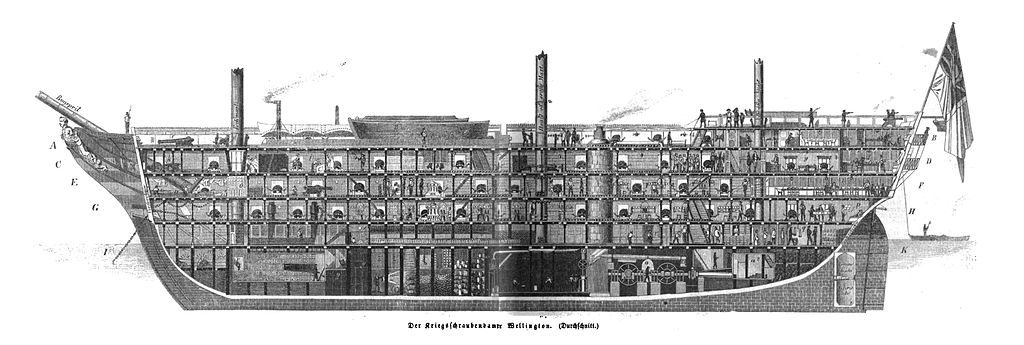
Duke of Wellington 1854 cutaway
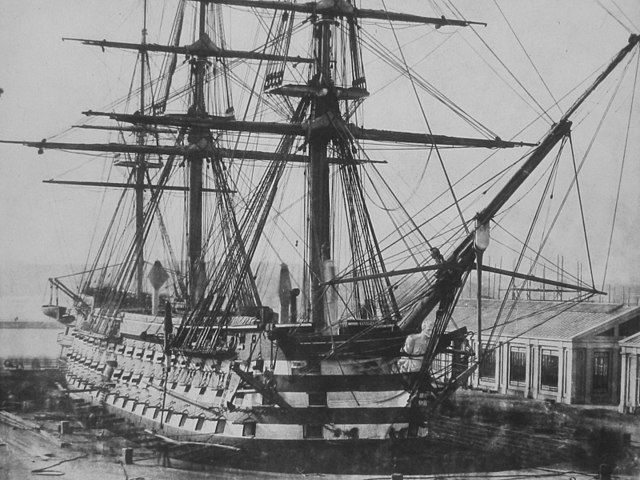

HMS Duke of Wellington at Keyham yard
Conversion of the Windsor Castle, which has already been launched, urged the need to cut the hull in half and lenghtened it by 9 meters to accomodate the steam engine and room for hundred of tons of coal. Total lenght of the hull reached then 73 meters (240 feet, without the bowsprit), and thanks to this early “jumboisation”.
The broadside gained some extra artillery, making herself after re-launching and re-christening (14 september 1852) HMS Duke of Wellington, in honor to the most important man in recent British History, just gone the very same day, the most powerful warship afloat. It dwarved the famous Victory, five generations older, and was on par with the most impressive flagships in the French and Russian fleets, proudly bearing the general’s bust as a figurehead.
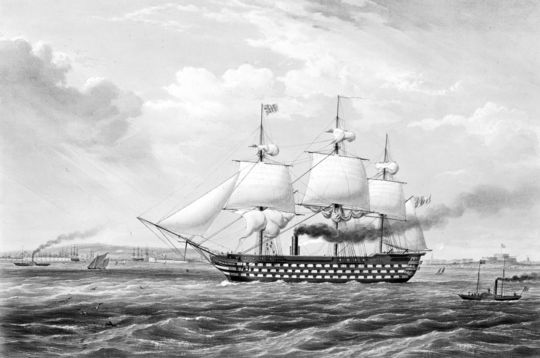
Completion came in january 1853, and the ship tonnage and size immediately captivated the British newspapers. With nearly 5900 tons, and a hundred meters overall, and broadside of 131 guns, totalling 382 tons alone, the ship was a masterpiece, and steam, at least nominally, greatly added to its potential, however its superb sailing capabilities were unchanged, as it was rigged for a maximal efficiency, demonstrated a 10,3 knots under sail alone during 1853 trials. The beam was 60ft (18,3m)and depth 27ft (8,2m).
The mainmast culminated to 55m above the quarterdeck. As it was customary for the time, the hull section was trapezoidal for a better stability. After its first sorties as Flagship of the channel fleet Western squadron, it became the flagship of Vice-admiral Sir Charles Napier, heading for the baltic sea. War just broke out with Russia. In 1853, it returned for the next operations in the baltics, as rear admiral Richard S. Dundas flagship, bombarding Sveaborg fortress.
After the war, she returned in Home waters to be paid off. Indeed, the hasty conversion and steam vibrations caused stresses on the hull, to the point that decomissioning as a mobile warship was the only option. She became a familiar sight for local sailors and an attaction for the photographs, usually called “Napier’s flagship”.
As Portsmouth saluting ship and naval HQ, she was kept moored until she was paid off again in 1888, but remained anchored there, partly restored and decorated for Queen Victoria Birthday fleet review. It last commanding officer was Rear-Admiral Sir David beatty, Britain battlecruiser force apostle. It was dismantled in 1904, its timber probably still part of Thames foreshore at Charlton.
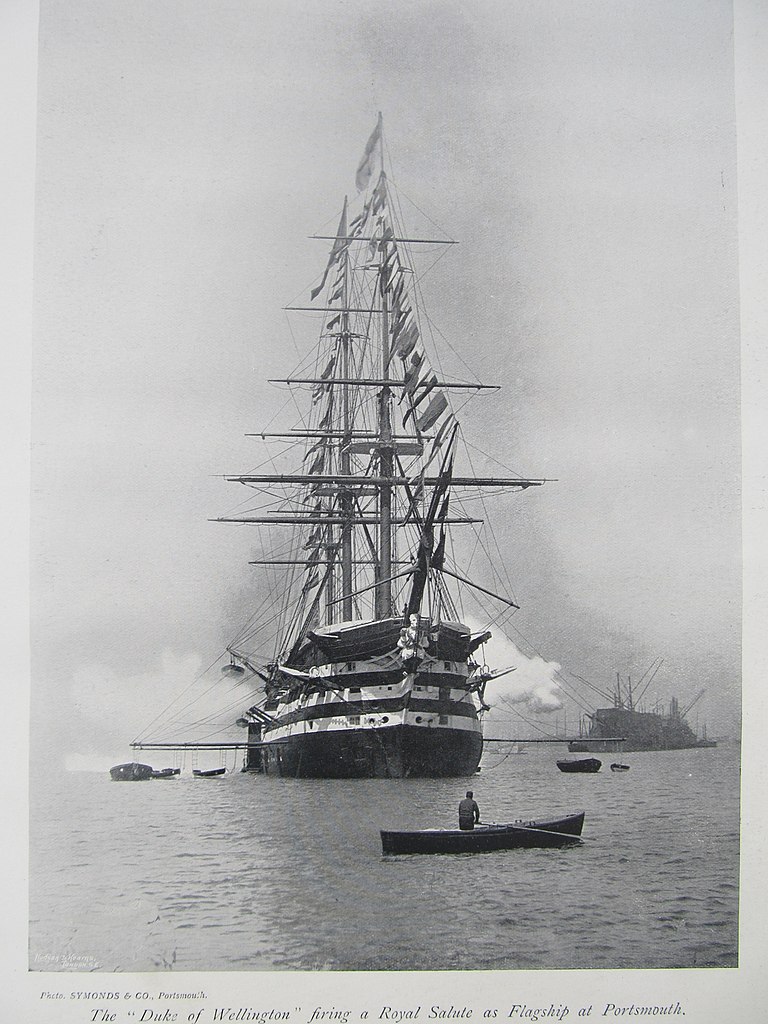

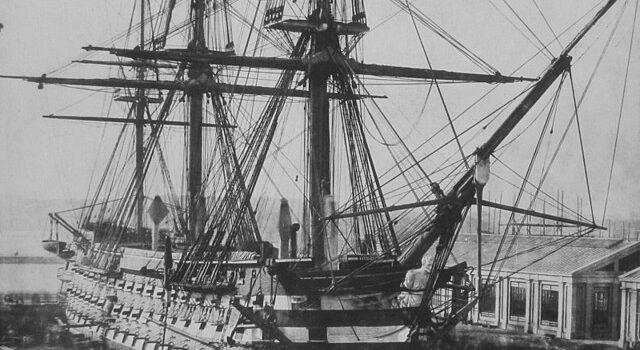
 Steamship of the line. Royal Navy in the Crimean War.
Steamship of the line. Royal Navy in the Crimean War.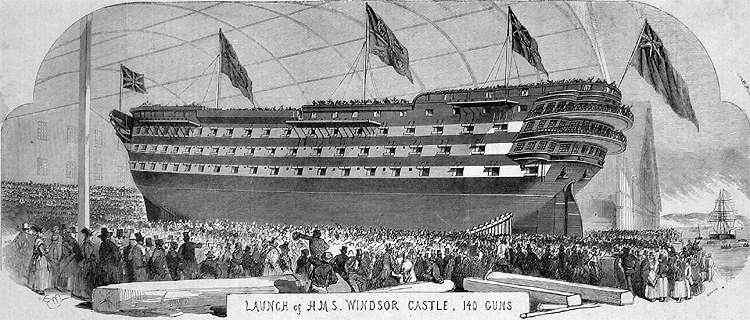
 Latest Facebook Entry -
Latest Facebook Entry -  X(Tweeter) Naval Encyclopedia's deck archive
X(Tweeter) Naval Encyclopedia's deck archive Instagram (@navalencyc)
Instagram (@navalencyc)





 French Navy
French Navy Royal Navy
Royal Navy Russian Navy
Russian Navy Armada Espanola
Armada Espanola Austrian Navy
Austrian Navy K.u.K. Kriegsmarine
K.u.K. Kriegsmarine Dansk Marine
Dansk Marine Nautiko Hellenon
Nautiko Hellenon Koninklije Marine 1870
Koninklije Marine 1870 Marinha do Brasil
Marinha do Brasil Osmanlı Donanması
Osmanlı Donanması Marina Do Peru
Marina Do Peru Marinha do Portugal
Marinha do Portugal Regia Marina 1870
Regia Marina 1870 Nihhon Kaigun 1870
Nihhon Kaigun 1870 Preußische Marine 1870
Preußische Marine 1870 Russkiy Flot 1870
Russkiy Flot 1870 Svenska marinen
Svenska marinen Søværnet
Søværnet Union Navy
Union Navy Confederate Navy
Confederate Navy Armada de Argentina
Armada de Argentina Imperial Chinese Navy
Imperial Chinese Navy Marinha do Portugal
Marinha do Portugal Mexico
Mexico Kaiserliche Marine
Kaiserliche Marine 1898 US Navy
1898 US Navy Sovietskiy Flot
Sovietskiy Flot Royal Canadian Navy
Royal Canadian Navy Royal Australian Navy
Royal Australian Navy RNZN Fleet
RNZN Fleet Chinese Navy 1937
Chinese Navy 1937 Kriegsmarine
Kriegsmarine Chilean Navy
Chilean Navy Danish Navy
Danish Navy Finnish Navy
Finnish Navy Hellenic Navy
Hellenic Navy Polish Navy
Polish Navy Romanian Navy
Romanian Navy Turkish Navy
Turkish Navy Royal Yugoslav Navy
Royal Yugoslav Navy Royal Thai Navy
Royal Thai Navy Minor Navies
Minor Navies Albania
Albania Austria
Austria Belgium
Belgium Columbia
Columbia Costa Rica
Costa Rica Cuba
Cuba Czechoslovakia
Czechoslovakia Dominican Republic
Dominican Republic Haiti
Haiti Hungary
Hungary Honduras
Honduras Estonia
Estonia Iceland
Iceland Eire
Eire Equador
Equador Iran
Iran Iraq
Iraq Latvia
Latvia Liberia
Liberia Lithuania
Lithuania Mandchukuo
Mandchukuo Morocco
Morocco Nicaragua
Nicaragua Persia
Persia San Salvador
San Salvador Sarawak
Sarawak Uruguay
Uruguay Venezuela
Venezuela Zanzibar
Zanzibar Warsaw Pact Navies
Warsaw Pact Navies Bulgaria
Bulgaria Hungary
Hungary

 Bundesmarine
Bundesmarine Dutch Navy
Dutch Navy Hellenic Navy
Hellenic Navy Marina Militare
Marina Militare Yugoslav Navy
Yugoslav Navy Chinese Navy
Chinese Navy Indian Navy
Indian Navy Indonesian Navy
Indonesian Navy JMSDF
JMSDF North Korean Navy
North Korean Navy Pakistani Navy
Pakistani Navy Philippines Navy
Philippines Navy ROKN
ROKN Rep. of Singapore Navy
Rep. of Singapore Navy Taiwanese Navy
Taiwanese Navy IDF Navy
IDF Navy Saudi Navy
Saudi Navy Royal New Zealand Navy
Royal New Zealand Navy Egyptian Navy
Egyptian Navy South African Navy
South African Navy






























 Ukrainian Navy
Ukrainian Navy dbodesign
dbodesign
My grandfather was on this ship from 03/11/1900 to 29/05/1901, he was called Benjamin Cox